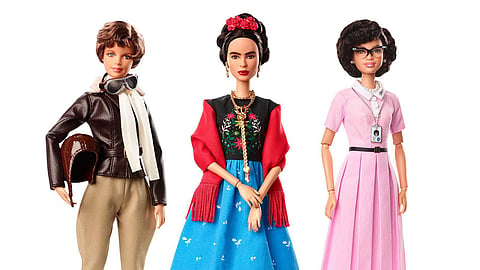

The upcoming release of the first live-action film based on the Barbie doll franchise (dozens of animated films have been made over the last two decades or so) seems to have gotten Mattel, the American company that owns it engaged in an inclusivity and diversity PR campaign. Interestingly, the premise of the movie is reported that the main Barbie protagonist gets exiled from Barbie Land for being a smidge less than perfect, as defined by the standards of that realm. The trailer hints at this plot; it is bright and light, full of in-jokes that adults like myself who grew up with the dolls and may have outgrown them but can catch the references will enjoy.
Launched in 1959, Barbie dolls of earlier decades were often criticised by feminists for upholding dangerous bodily standards. Aside from a hyper feminised bust and waist, the anatomical extremity of the dolls was often noted (including that a person who shared these measurements would not be able to balance on their feet). Then there was the whiteness issue: Blonde, blue-eyed dolls represented a single beauty standard that dominated the world until recently. Mattel took ages to get around to it, but they eventually introduced dolls of colour, in the form of multicultural Barbies and her sidekicks from that universe. Then, there was also the role model question: Mattel responded well with a range of career Barbies (there has been a Barbie President, but there is yet to be a woman in that position in the United States). Still, a baseline of unrealistic and problematic depictions of the doll has been linked to eating disorders and other forms of body dysmorphia.
When it comes to humanoid toys, representation matters. This is why, even if it has taken the company an unjustifiable amount of time to do it, their new line of disabled dolls—named Fashionistas Barbie—is a welcome move. It was announced in August 2022, a year ahead of the film’s release. The line will feature dolls who use hearing aids, prosthetic legs, wheelchairs, and even a Ken doll with vitiligo. A Barbie with Downs’ Syndrome has just debuted.
Toys aren’t just toys, just as stories aren’t just stories. This is also why cinema and literature made for children that portray characters who look like them, have familiar names, and come from relatable backgrounds are important. Children need entertainment that mirrors, inspires, teaches, and brings delight. Sometimes one toy, one book, or one film can do all those things—not to every audience, but that is the point. There are many audiences; this is why accessible, mainstream diversity matters.
On a completely different note, there’s also now a Scary Barbie—not a plaything at all, but a supermassive black hole that has just been detected by astronomers. It is the most luminous space phenomena of its kind ever recorded and has been observed shredding a star with a ferocity of nearly unimaginable power. It was given a random designation—ZTF20abrbeie—which gave rise to its deceptively cute, but rather well-timed, name.